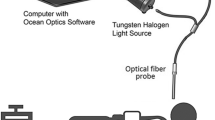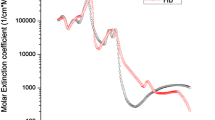Early-warning changes in precancerous epithelial cells can now be spotted in situ.
Abstract
More than 85% of all cancers originate in the epithelium that lines the internal surfaces of organs throughout the body. Although these are readily treatable provided they are diagnosed in one of the preinvasive stages1, early lesions are often almost impossible to detect. Here we present a new optical-probe technique based on light-scattering spectroscopy that is able to detect precancerous and early cancerous changes in cell-rich epithelia.

Similar content being viewed by others
References
Cotran, R. S., Robbins, S. L. & Kumar, V. Robbins Pathological Basis of Disease (Saunders, Philadelphia, 1994).
Van de Hulst, H. C. Light Scattering by Small Particles (Dover, New York, 1957).
Perelman, L. T. et al. Phys. Rev. Lett. 80, 627– 630 (1998).
Backman, V. et al. IEEE J. Sel. Top. Quant. 5, 1019– 1026 (1999).
Author information
Authors and Affiliations
Corresponding author
Rights and permissions
About this article
Cite this article
Backman, V., Wallace, M., Perelman, L. et al. Detection of preinvasive cancer cells. Nature 406, 35–36 (2000). https://doi.org/10.1038/35017638
Issue Date:
DOI: https://doi.org/10.1038/35017638
- Springer Nature Limited
This article is cited by
-
Real-time simultaneous refractive index and thickness mapping of sub-cellular biology at the diffraction limit
Communications Biology (2024)
-
Video-rate hyperspectral camera based on a CMOS-compatible random array of Fabry–Pérot filters
Nature Photonics (2023)
-
In vivo detection of bile duct pre-cancer with endoscopic light scattering spectroscopy
Nature Communications (2023)
-
Spatial helicity response metric to quantify particle size and turbidity of heterogeneous media through circular polarization imaging
Scientific Reports (2023)
-
Optical characterization of the liver tissue affected by fibrolamellar hepatocellular carcinoma based on internal filters of laser-induced fluorescence
Scientific Reports (2022)





